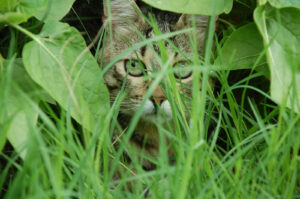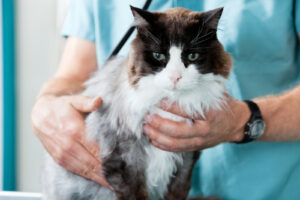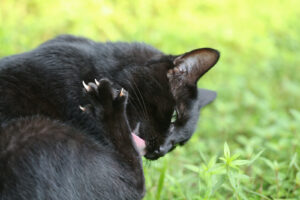Barks Blog
Pain Underlying
By Dr. Lynn Bahr

Most people who work professionally with cats know what stoic creatures they are and how well they can hide their pain. There are many different theories as to why this is. Until relatively recently, it was thought cats did not experience pain at all, based purely on the fact that they tend not to show it. Some people — including some feline professionals — even still believe this, despite significant advances to the contrary.
It is an astounding reality that, in the year 2017, we still find the subject of pain sufficiently mysterious and elusive that we are only just beginning to acknowledge its existence in animals. Pain is a complex subject even in human medicine, despite the fact that people are able to communicate how they feel, and the complexity is only magnified when working with animals, given that they lack the ability to communicate verbally.
We cannot change what we do not know and there is so much in veterinary medicine that we have not learned yet. Just because animals do not complain about headaches we might assume they do not suffer from them like we do. Is it possible that cats living with chronic congestion and deep sinus infections feel just as badly as people with the same ailments? These people still manage to work and live their lives as normally as possible. However, many are miserable, exhausted and even depressed. Medical conditions known to contribute to chronic pain in people also exist in animals, but are often overlooked or ignored. Because animals often suffer in silence it is easy for their pain to go unnoticed and untreated.
What Do We Know About Pain?

Pain is considered to consist of three key components: a sensory-discriminatory component (temporal, spatial, thermal/mechanical), an affective component (subjective and emotional, describing associated fear, tension and autonomic responses), and an evaluative component, describing the magnitude of the quality (e.g. stabbing/ pounding; mild/severe) (World Small Animal Veterinary Association, 2014).
Pain can be classified as acute or chronic. Acute pain typically has a sudden onset and is usually the result of a clearly defined cause such as an injury. It is the body’s normal response to damage such as a cut, an infection, or other physical injuries. Acute pain is usually short lived (under six months) and resolves with the healing of its underlying cause. Chronic pain is viewed more as its own disease rather than as a symptom of another health problem. It can be affected by physical (sitting or standing), environmental (weather changes), and psychological (stress) factors. Chronic pain signals remain active in the nervous system for weeks, months, or years. In people, physical effects include tense muscles, limited mobility, a lack of energy, and changes in appetite. Emotional effects include depression, anger and anxiety (Cleveland Clinic, 2017).
In cats, we know a lot more about acute pain than chronic. In general, responses to acute surgical and traumatic pain are likely to be more marked and readily recognizable than clinical signs associated with chronic pain. The veterinary profession has pain scoring scales like the Glasgow Feline Composite Measure Pain Scale and the UNESP-Botucatu Multidimensional Composite Pain Scale for Assessing Postoperative Pain in Cats, but despite all the research, data and recommendations, the consensus remains that assessing acute pain in cats is difficult, subjective and extremely underutilized. Recognizing chronic pain is even more elusive, and assessing it in cats is virtually non-existent amongst most veterinary professionals.
Why Do Cats Hide Their Pain?

We know that hiding pain and discomfort from illness or injury is a natural feline behavior. It is believed to be an integral part of their survival strategy for several reasons. Perhaps it is due to their feeding pattern and need to hunt even when injured or in pain, or the fact that they would be preyed upon more easily if weak or sick. Rarely will a cat vocalize his pain because, instead of calling for help, it would simply alert a larger predator to his vulnerability. Within colonies, weaker cats lose status and power, and often have to give up the best hunting grounds. Hiding weakness is a natural way for cats to avoid the threat of displacement by stronger members of the colony.
Common Conditions that Cause Chronic Pain
Osteoarthritis is the number one cause of chronic pain in cats and studies have shown that over 90 percent of cats aged 12 years and over, 60 percent of cats aged 6-12 years, and over 20 percent of all cats aged 1-6 years show some signs of arthritis (Kornya, 2016).
Prevalent inflammatory conditions that cats suffer from can become chronic in nature; stomatitis, pancreatitis, cystitis and inflammatory bowel disease to name a few. These conditions are often very painful, may wax and wane, and result in poor quality of life. Many are thought to be caused by stress and, conversely, living with these conditions often leads to additional stress.
Tooth resorption is a common condition affecting an estimated 20 percent to 60 percent of all cats and close to 75 percent of cats aged 5 years of age and older. Resorptive lesions that have eroded through the enamel are very painful, yet cats still manage to eat well – which just confirms what we know about how effectively they can hide their pain.
Declawing is a widespread and routine procedure with up to 5,000 felines a day undergoing this extremely painful procedure in the United States. The procedure is banned in many other countries (see The Effects of Declawing, BARKS from the Guild, March 2017, pp. 44-46). The removal of up to 20 digits at a time is not unusual and many undergo these amputations with minimal pain protocols, anesthetics or follow-up exams.
Pain management specialist Dr. James S. Gaynor (2012) believes there is a type of chronic pain that is due to a phenomenon called “wind-up.” Wind-up is an increase in pain intensity over time that, in the case of declawing, can develop either during a surgical procedure or in the days to weeks afterward. The surgery and pain associated with it may, on its own, cause chronic pain to develop.
According to Dr. Jean Hovre (2012), virtually 100 percent of human amputees experience phantom sensations (80 percent of them painful) for the rest of their lives, no matter how or when the amputation occurred – even as an infant, even with the perfect surgical technique, and even with abundant post-op pain meds. Given the prevalence of declawed cats in the United States, is it possible many are experiencing and dealing with chronic pain that is adversely affecting their personality and behavior? We know that 20 percent of cats are dealing with osteoarthritis yet veterinary practices are not treating 20 percent of their feline patients for it. Could a similar phenomenon be occurring with cats that have been declawed?
Common Signs of Pain
As mentioned previously, signs of pain in cats are often subtle. Although they may spend less time playing, hunting and running, cat owners rarely mention these subtle changes to veterinarians. Signs may include:
– Reduced activity.
– Loss of appetite, change of appetite, difficulty chewing.
– Quiet/loss of curiosity.
– Changes in urinary/defecation habits.
– Hiding.
– Hissing or spitting.
– Decreased agility/jumping.
– Excessive licking/grooming.
– Stiff posture/gait.
– Guarding behavior.
– Stops grooming/matted fur.
Behavioral Changes Associated with Chronic Pain
Pain is not a symptom that exists alone. Other problems associated with pain can include fatigue, withdrawal from activity and increased need to rest, and changes in mood, including fear, depression, anxiety, irritability and stress. In humans, we know that long-term pain has a profound effect on quality of life and we might assume the same holds true for animals. Aside from the physical suffering that it causes, there are also psychological and personality effects associated with chronic pain.
Cats who are irritable at home, fractious at the clinic, picked on by other cats, are matted, or lack motivation should all be assessed for the possibility of pain as an underlying factor to their behavior. We know that cats with oral pain may appear ill-tempered or aggressive, have a change in appetite or food preference, and may have difficulty chewing and eating (food falls from their mouth). As is typical of most cats, these cats rarely show overt signs of pain or discomfort but rather tend to endure it silently. Owners are often amazed by their cat’s sudden return to “acting like a kitten again” after extractions of painful teeth. As a feline veterinarian, it is not unusual for me to see oral cavities and missing teeth due to resorption. While we know how slow and painful the process is, it often occurs completely unnoticed by owners.
Similar behavioral changes may be seen in cats that have been declawed. Many are sedentary and show decreased interest in play, while others are simply irritable, cranky, or fearful. Their underlying chronic pain often leads to withdrawal, fear, anxiety and depression. It is amazing for me to see declawed cats transformed into social beings once their pain is recognized and treated appropriately. Alleviating their discomfort can be remarkable and certainly increases their quality of life.
While many people pass off decreased grooming and increased matting to “old age,” the more likely cause is increased arthritic pain. One might say that feeling good is looking good, and this is true for cats too. Those dealing with chronic pain or illnesses frequently avoid activities that hurt, and adjust their lifestyle accordingly. Behavioral issues like inappropriate urination, increased irritability and even aggressiveness can all stem from the effects of living with constant, unrelenting pain.
While hiding pain is effective for survival in the wild, it is not a trait that serves the domesticated cat well. Since cats tend to be introverted about their discomfort, their pain may easily go unnoticed and even cats in severe pain will attempt to minimize their vulnerability. Fortunately, this is a subject that has been gaining traction and new research has been devoted to finding ways to better recognize, assess, and treat animals experiencing pain. With this new knowledge we can better serve our feline companions by advocating on their behalf to ensure their pain is acknowledged, controlled and kept to a minimum.
As feline professionals, it is incumbent on us to bring additional attention to the recognition and treatment of chronic pain to owners, veterinarians, caretakers, and everyone who is involved in caring for cats. It is also our moral and ethical duty to mitigate suffering to the best of our ability and this begins by evaluating pain at every patient contact. It is important to remember, just because we do not know much about it, it does
not mean we should not be looking for it and treating it more often.
References
Cleveland Clinic. (2017). Acute Pain vs. Chronic Pain.
Gaynor, J.S. (2005, April). Chronic pain syndrome of feline onychectomy. North American Veterinary Conference Clinician’s Brief.
Hovre, J. (2012). Chronic Pain of Declawing.
Kornya, M. (2016). Arthritis (Osteoarthritis or Degenerative Joint Disease) in Cats. Wyckoff, NJ: Winn Feline Foundation.
World Small Animal Veterinary Association. (2014). Guidelines for Recognition, Assessment and Treatment of Pain, 55(6), E-10-E68. (May 20, 2104).
Resources
Glasgow Feline Composite Measure Pain Scale: www.bit.ly/2pYcCf8
Lehet, B. (2017, March). The Effects of Declawing. BARKS from the Guild (23) 44-46.
UNESP-Botucatu Multidimensional Composite Pain Scale for Assessing Postoperative Pain in Cats: www.bit.ly/2qn5drh
This article was first published in BARKS from the Guild, July 2017, pp. 43-45.
About the Author
Dr. Lynn Bahr is a graduate of the University of Georgia, College of Veterinary Medicine who credits a special grey and white ball of kitten fluff with leading her down the path of a career in feline medicine and behavior. Her areas of interest and special care for felines include health and wellness, lifetime enrichment, hospice care, strengthening the animal-human bond, ending the practice of declawing, and the ability to speak cat. Dr. Bahr is currently the CEO of Dezi & Roo, a company that manufactures and sells solution-based pet products. She is a Fear Free certified professional and serves on the board of directors for Pandemonium Aviaries.

